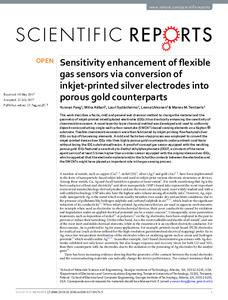Sensitivity enhancement of flexible gas sensors via conversion of inkjet-printed silver electrodes into porous gold counterparts
Fang, Yunnan; Akbari, Mitra; Sydänheimo, Lauri; Ukkonen, Leena; Tentzeris, Manos M. (2017-12-01)
Fang, Yunnan
Akbari, Mitra
Sydänheimo, Lauri
Ukkonen, Leena
Tentzeris, Manos M.
01.12.2017
8988
Julkaisun pysyvä osoite on
https://urn.fi/URN:NBN:fi:tty-201709041865
https://urn.fi/URN:NBN:fi:tty-201709041865
Kuvaus
Peer reviewed
Tiivistelmä
This work describes a facile, mild and general wet chemical method to change the material and the geometry of inkjet-printed interdigitated electrodes (IDEs) thus drastically enhancing the sensitivity of chemiresistive sensors. A novel layer-by-layer chemical method was developed and used to uniformly deposit semiconducting single-wall carbon nanotube (SWCNT)-based sensing elements on a Kapton® substrate. Flexible chemiresistive sensors were then fabricated by inkjet-printing fine-featured silver IDEs on top of the sensing elements. A mild and facile two-step process was employed to convert the inkjet-printed dense silver IDEs into their highly porous gold counterparts under ambient conditions without losing the IDE-substrate adhesion. A proof-of-concept gas sensor equipped with the resulting porous gold IDEs featured a sensitivity to diethyl ethylphosphonate (DEEP, a simulant of the nerve agent sarin) of at least 5 times higher than a similar sensor equipped with the original dense silver IDEs, which suggested that the electrode material and/or the Schottky contacts between the electrodes and the SWCNTs might have played an important role in the gas sensing process.
Kokoelmat
- TUNICRIS-julkaisut [16929]
